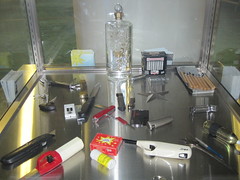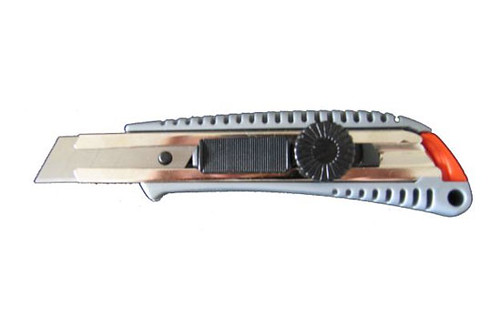It's time to get into the habit of letting go of excess stuff, rather than finding a place to stuff it. Having to walk around stuff or over stuff does not make for a peaceful living environment. Let's go room by room and take care of some of the most common clutter problems.

1.) Kitchen: ask yourself what items do I use daily?
Box Cutter
These items really deserve the primetime space in your kitchen. They should be within arms reach in the best location available. Watch out for space hogs in the kitchen such as multiple coffee mugs, plastic bags and cleaning products.
2.) Next ask yourself how many of each of these items you need to have a reasonable amount on hand.
Do you have 6 of something but only use one. This is a common problem. Setting limits will help you maintain an organized kitchen easily. Any broken, stained or chipped items need to go.
3.) Donate or discard your extra items, or in the case of glasses or dishes store them in long term storage until needed.
That is only if you have room in or for long-term storage. If you already have a long term storage problem go ahead and get rid of your excess, unless its an item that you can not replace like grandma's good china, in that case get rid of something else and store grandma's china. Remember to periodically go through cabinets and drawers to purge extras and replace worn out or damaged pieces.
4.) Clear your counters: the most visible part of your kitchen.
Start by clearing all items into boxes or onto trays. Take this opportunity to clean your counters thoroughly. Now put back only the items that you use daily. Ex. Toaster, coffeemaker, crocks of utensils. Only display decorative items on you countertop if you have plenty of space to do so. Otherwise decorations in moderation should be on the walls to save valuable real estate in the kitchen.
5.) Discourage paper piles from forming by creating a RAF file or as some people call it an action file.
A RAF file can be anything that can hold 3 files or folders. RAF stands for read, act, and file. As paper comes into your house you need to use your RAF file to place each piece either in to read, to act (meaning you need to do an action) or to file. Each piece of paper you save is important for one reason or another so you need to be able to find it quickly. Then of coarse there is the trashcan, use it regularly. You can also set up binders with clear plastic pages for things like receipts, recipes, take out menus, school information and frequently called numbers.
6.) Clean off your fridge!
Scale down or eliminate old refrigerator magnets or at least move them to one side. Clear everything off the front, put important items such as take out menus in a binder or in your RAF file. Save your kids best artwork in a plastic bin with their name on it, be sure to write their age on the back with an acid free pencil or acid free pen that you can find in the scrap booking section of any store. Once the fridge is clear, only put back current items.
TIP: Keep a wipe off calendar on the front of you fridge, update it the 1st of every month from you pocket calendar that you keep in your pocketbook or briefcase. That way you won't miss any appointments or meeting or double schedule yourself.
7.) Bathroom: Clean out your medicine cabinets.
Dispose of expired medicines and toss bottles of perfume, lotion and nail polish that are almost empty. Keep on the products that you like and use. Don't keep products that you either didn't like or were not effective just because of what it cost you. In the long run they cost you more in space wasted.
8.) Clean out stuffed drawers.
Ok we have all done it at one time or another shoved one more item into an already full drawer. Now it's time to change all that. Go drawer by drawer take everything out and ask yourself "Do I love this?" Do I need this?" Why am I keeping this?" The answers to these questions will tell you what you need to do. Then you keep it, donate it or toss it. By lightening up your drawers you will reduce stress and be able to find the things you need faster and easier.
9.) Clear bathroom counter.
It makes it so much easier to get ready in the morning and reduces stress when your bathroom counters are clear. This is also a time save because cleaning is a breeze. See tip #12 for the solution to where to put all the stuff you cleared off the counter.
10.) Use your wall space.
If you're hard pressed for storage solutions look to your walls. There are many options to create storage and reduce clutter on countertops. Ask yourself is there anywhere that I can add a shelf or shelves? Maybe a wall soap dish or toothbrush holder. Look on EBAY for hotel towel holders they hold 2 bath towels, 2 hand towels and 2 washcloths each.
11.) Create a peaceful retreat.
Most bathroom tubs and showers seem to be over flowing with bottles of shampoo, conditioner, bath toys and body washes. Again start by removing all items; clean the surfaces well with a soap scum-removing product. Then only put back the products that you use on a daily basis. Consider getting a shower caddy if you don't already have one and a stick on basket or bag for the kid's toys.
12.) Make personal bath totes.
Each member of your family should have their own container to store and transport their own personal bath items. This container can be a small plastic crate, a wicker basket or any other small container that can hold your items neatly. Placing each family members items in their own container makes it easy to store these things under the bathroom sink or in the bathroom or in the linen closet until they are needed. This also keeps their personal hygiene items together making it easy to find their comb or hair detangler and its no problem to move to another bathroom when company comes.
13.) Create a peaceful haven.
Your bedroom should be a place where you can rest. It is not the place to do work or other stressful activities. Do not allow things not related to sleep to accumulate there. This room should contain a bed, dresser, nightstands, lamp and maybe a chair or bench. Do not over crowd your bedroom with furniture it will make it feel small and will not promote peace. Your nightstand should be clear except for reading glasses (if you need them), a book or magazine (just one, not a pile), alarm clock and maybe some tissues. Start by clearing the room of all excess stuff, only put back those items that promote peace and rest. Donate or store extra items elsewhere.
14.) Remember the one in one out rule.
Once you have your house down to where it looks and feels good for every new item that you acquire you will need to donate, sell or give away one item. One for one, it's the only way to maintain the balance that you have achieved.
15.) Place 4 containers in your laundry room.
There are 4 containers every laundry room should have. Three of them can be boxes, bags, laundry baskets or whatever you have on hand. The last one is a trashcan. Label your containers, donate, mending, rags and trash. The donate box means that you continually separate out items that are past their prime but still have some wear or are too small. The mending means that you need to do a small repair. Rags means they have holes or bad stains so you can use them to clean or stain furniture, cotton or wool clothing make the best rags. The trashcan is for items found in pockets, dryer lint and other trash. This way it doesn't pile up on your dryer eventually making its way to the floor.
There you have it 15 steps to a clutter free home.
